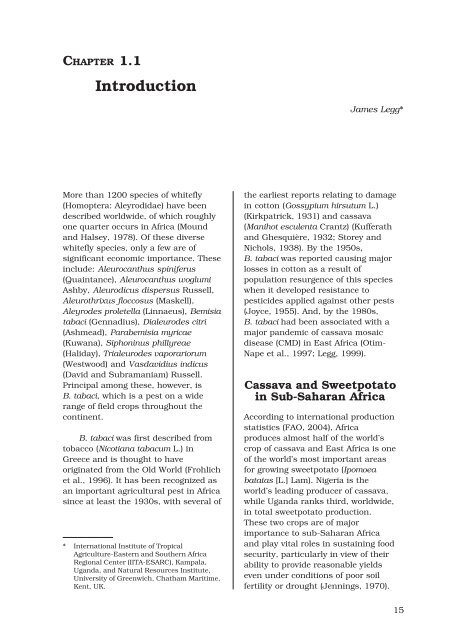Whitefly and whitefly-borne viruses in the tropics : Building a ... - cgiar
Whitefly and whitefly-borne viruses in the tropics : Building a ... - cgiar
Whitefly and whitefly-borne viruses in the tropics : Building a ... - cgiar
You also want an ePaper? Increase the reach of your titles
YUMPU automatically turns print PDFs into web optimized ePapers that Google loves.
Introduction<br />
CHAPTER 1.1<br />
Introduction<br />
More than 1200 species of <strong>whitefly</strong><br />
(Homoptera: Aleyrodidae) have been<br />
described worldwide, of which roughly<br />
one quarter occurs <strong>in</strong> Africa (Mound<br />
<strong>and</strong> Halsey, 1978). Of <strong>the</strong>se diverse<br />
<strong>whitefly</strong> species, only a few are of<br />
significant economic importance. These<br />
<strong>in</strong>clude: Aleurocanthus sp<strong>in</strong>iferus<br />
(Qua<strong>in</strong>tance), Aleurocanthus woglumi<br />
Ashby, Aleurodicus dispersus Russell,<br />
Aleurothrixus floccosus (Maskell),<br />
Aleyrodes proletella (L<strong>in</strong>naeus), Bemisia<br />
tabaci (Gennadius), Dialeurodes citri<br />
(Ashmead), Parabemisia myricae<br />
(Kuwana), Siphon<strong>in</strong>us phillyreae<br />
(Haliday), Trialeurodes vaporariorum<br />
(Westwood) <strong>and</strong> Vasdavidius <strong>in</strong>dicus<br />
(David <strong>and</strong> Subramaniam) Russell.<br />
Pr<strong>in</strong>cipal among <strong>the</strong>se, however, is<br />
B. tabaci, which is a pest on a wide<br />
range of field crops throughout <strong>the</strong><br />
cont<strong>in</strong>ent.<br />
B. tabaci was first described from<br />
tobacco (Nicotiana tabacum L.) <strong>in</strong><br />
Greece <strong>and</strong> is thought to have<br />
orig<strong>in</strong>ated from <strong>the</strong> Old World (Frohlich<br />
et al., 1996). It has been recognized as<br />
an important agricultural pest <strong>in</strong> Africa<br />
s<strong>in</strong>ce at least <strong>the</strong> 1930s, with several of<br />
* International Institute of Tropical<br />
Agriculture-Eastern <strong>and</strong> Sou<strong>the</strong>rn Africa<br />
Regional Center (IITA-ESARC), Kampala,<br />
Ug<strong>and</strong>a, <strong>and</strong> Natural Resources Institute,<br />
University of Greenwich, Chatham Maritime,<br />
Kent, UK.<br />
James Legg*<br />
<strong>the</strong> earliest reports relat<strong>in</strong>g to damage<br />
<strong>in</strong> cotton (Gossypium hirsutum L.)<br />
(Kirkpatrick, 1931) <strong>and</strong> cassava<br />
(Manihot esculenta Crantz) (Kufferath<br />
<strong>and</strong> Ghesquière, 1932; Storey <strong>and</strong><br />
Nichols, 1938). By <strong>the</strong> 1950s,<br />
B. tabaci was reported caus<strong>in</strong>g major<br />
losses <strong>in</strong> cotton as a result of<br />
population resurgence of this species<br />
when it developed resistance to<br />
pesticides applied aga<strong>in</strong>st o<strong>the</strong>r pests<br />
(Joyce, 1955). And, by <strong>the</strong> 1980s,<br />
B. tabaci had been associated with a<br />
major p<strong>and</strong>emic of cassava mosaic<br />
disease (CMD) <strong>in</strong> East Africa (Otim-<br />
Nape et al., 1997; Legg, 1999).<br />
Cassava <strong>and</strong> Sweetpotato<br />
<strong>in</strong> Sub-Saharan Africa<br />
Accord<strong>in</strong>g to <strong>in</strong>ternational production<br />
statistics (FAO, 2004), Africa<br />
produces almost half of <strong>the</strong> world’s<br />
crop of cassava <strong>and</strong> East Africa is one<br />
of <strong>the</strong> world’s most important areas<br />
for grow<strong>in</strong>g sweetpotato (Ipomoea<br />
batatas [L.] Lam). Nigeria is <strong>the</strong><br />
world’s lead<strong>in</strong>g producer of cassava,<br />
while Ug<strong>and</strong>a ranks third, worldwide,<br />
<strong>in</strong> total sweetpotato production.<br />
These two crops are of major<br />
importance to sub-Saharan Africa<br />
<strong>and</strong> play vital roles <strong>in</strong> susta<strong>in</strong><strong>in</strong>g food<br />
security, particularly <strong>in</strong> view of <strong>the</strong>ir<br />
ability to provide reasonable yields<br />
even under conditions of poor soil<br />
fertility or drought (Jenn<strong>in</strong>gs, 1970).<br />
15
















